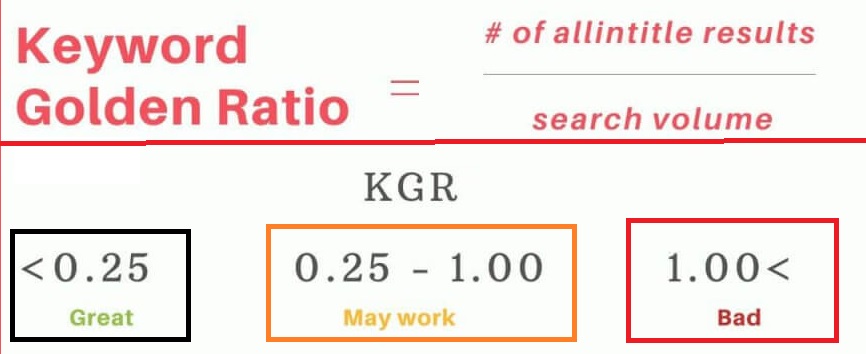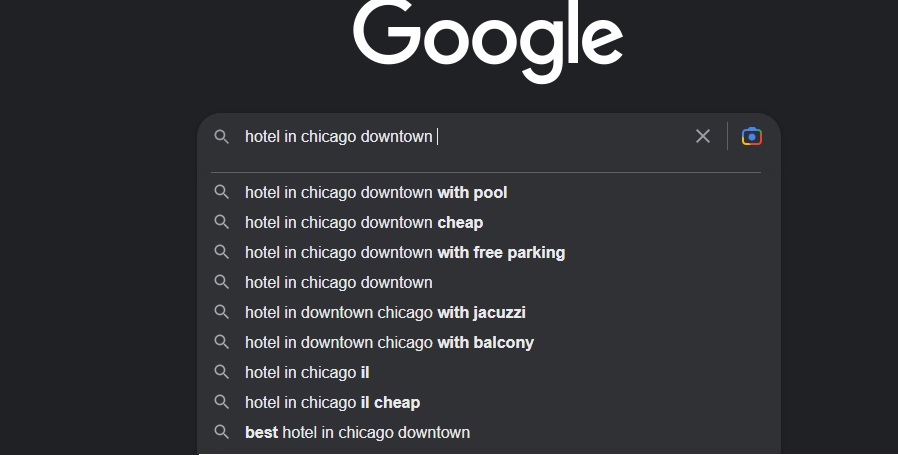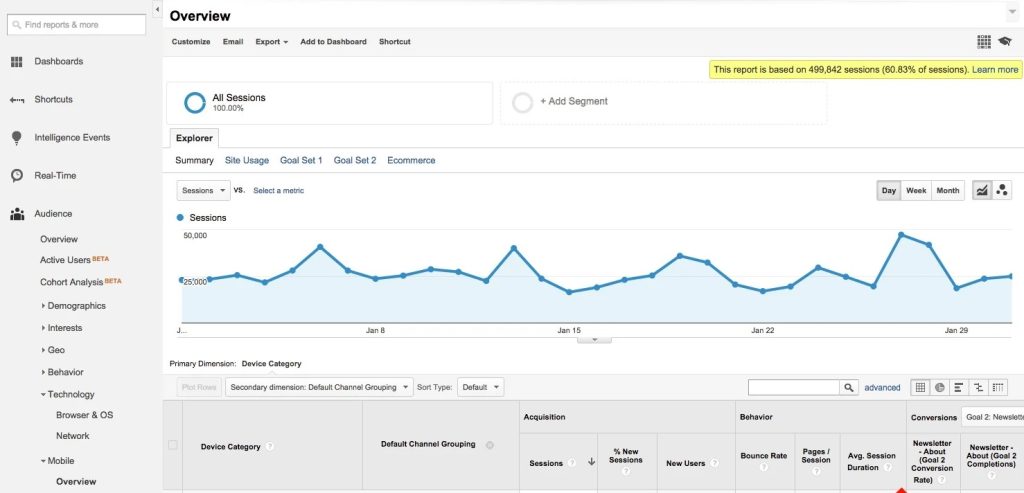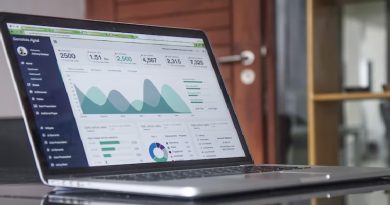Benefits of using KGR Keyword Golden Ratio
KGR or Keyword Golden Ratio is a popular SEO strategy that help in order to drive traffic to your website.Here we will discussed about benefits of using KGR Keyword Golden Ratio. The KGR is a simple formula that involves finding keywords with a low keyword difficulty score and a low search volume.
What is KGR
Keyword Golden Ratio (KGR) is a popular SEO strategy that involves finding low-competition keywords to rank for in order to drive traffic to your website.To find a KGR keyword, you first need to identify a broad topic that you want to write about. Once you have your topic, use a keyword research tool to find related keywords. Look for keywords that have a search volume of less than 250 per month and a keyword difficulty score of less than 0.25.
When targeting KGR keywords, it’s important to consider the user intent behind the keyword and create content that matches that intent. For example, if you’re targeting a KGR keyword with informational intent, you should create content that provides valuable information on that topic. If you’re targeting a KGR keyword with transactional intent, you should create content that encourages users to make a purchase.
Benefits of using KGR
Once you have identified a KGR keyword, create a piece of content that targets that keyword. This could be a blog post, article, or video. Make sure that your content is high-quality and provides value to your audience.
One of the advantages of the KGR strategy is that it allows you to rank for keywords that are often overlooked by your competitors. By targeting low-competition keywords, you have a better chance of ranking on the first page of Google search results, which can drive more traffic to your website.

KGR (Keyword Golden Ratio) and SEO (Search Engine Optimization) relation
It’s important to note that the KGR strategy is just one of many SEO strategies that you can use to improve your website’s ranking. While it can be effective, it’s not a silver bullet solution. To see lasting results, you’ll need to combine the KGR strategy with other SEO tactics, such as building quality backlinks and optimizing your website’s on-page SEO.
The Keyword Golden Ratio is a powerful SEO strategy that can help you drive traffic to your website by targeting low-competition keywords. By creating high-quality content that targets these keywords, you can improve your website’s ranking on search engines like Google. However, it’s important to remember that the KGR strategy is just one piece of the SEO puzzle and should be used in conjunction with other tactics to see lasting results.
To further optimize your KGR strategy, it’s important to consider the user intent behind the keywords you’re targeting. User intent refers to the reason behind a user’s search query, and it’s important to understand because Google’s algorithm is designed to show search results that best match the user’s intent.
Types of user intent
There are four main types of user intent: informational, navigational, transactional, and commercial investigation. Informational intent refers to users who are looking for information on a particular topic, while navigational intent refers to users who are looking for a specific website or page. Transactional intent refers to users who are looking to make a purchase, while commercial investigation intent refers to users who are researching a product or service before making a purchase.
Another important factor to consider when targeting KGR keywords is the relevance of your content to the keyword. Google’s algorithm is designed to show search results that are most relevant to the user’s search query, so it’s important to ensure that your content is highly relevant to the keyword you’re targeting. Make sure that your content is comprehensive and provides all the information that a user would expect to find when searching for that keyword.
In conclusion, the Keyword Golden Ratio is a powerful SEO strategy that can help you drive traffic to your website by targeting low-competition keywords. To optimize your KGR strategy, it’s important to consider the user intent behind the keywords you’re targeting and create high-quality, relevant content that matches that intent. By doing so, you can improve your website’s ranking on search engines and drive more traffic to your site.
In addition to targeting KGR keywords with the right user intent and relevant content, there are a few other best practices to keep in mind when implementing this SEO strategy. Here are some tips:
Use long-tail keywords:
Long-tail keywords are longer, more specific phrases that are less competitive than broader keywords. They also tend to have a higher conversion rate because they are more targeted. When using the KGR strategy, try to focus on long-tail keywords that have a search volume of less than 250 per month.

Include the keyword in your title tag and meta description:
The title tag and meta description are two of the most important on-page SEO elements. Make sure to include your target keyword in both the title tag and meta description to improve your chances of ranking for that keyword.
Use the keyword naturally in your content: When creating content, avoid keyword stuffing (i.e., overusing the target keyword). Instead, use the keyword naturally throughout the content and in related phrases.
Promote your content:
Once you’ve created your KGR content, promote it through social media, email marketing, and other channels to help drive traffic to your site.
Monitor your results:
Keep track of your website’s ranking for your target KGR keywords and adjust your strategy as needed. If you’re not seeing results, consider targeting different keywords or adjusting your content strategy.
By following these best practices, you can optimize your KGR strategy and improve your chances of ranking for low-competition keywords. Remember, though, that SEO is a long-term strategy and results may take time to show. Consistency and persistence are key to seeing success with the KGR strategy or any other SEO strategy.

How to find KGR keywords
To find KGR keywords, you need to follow these steps:
Generate a list of potential keywords:
Start by brainstorming a list of potential keywords that are relevant to your niche or topic. You can use tools such as Google Keyword Planner, SEMrush, Ahrefs, or Ubersuggest to generate keyword ideas.
Find search volume:
Once you have a list of potential keywords, use a keyword research tool to find their monthly search volume. This will give you an idea of how many people are searching for each keyword.
Find keyword competition:
Determine the keyword competition for each keyword by looking at the number of search results in Google when you type in the keyword phrase in quotes. This will tell you how many pages are optimized for that specific keyword.
Calculate KGR:
Use the formula (Search Volume / Keyword Competition) to calculate the KGR for each keyword. The lower the KGR, the more likely you are to rank for that keyword.
Prioritize KGR keywords:
Once you have calculated the KGR for each keyword, prioritize the ones with the lowest KGR. These are the keywords that have low competition and high search volume, making them ideal for targeting.
Create content:
Once you have identified your KGR keywords, create high-quality content that targets those keywords. Make sure your content is relevant, valuable, and engaging to your target audience.
Monitor your results:
Keep track of how your content is performing for each KGR keyword. Monitor your website traffic, rankings, and conversions to determine if your KGR strategy is working effectively.
Strategies for ongoing KGR optimization
Once you have identified and created content around KGR keywords, it’s important to continue optimizing them for ongoing success. Here are some strategies for ongoing KGR optimization:
Update your content:
As your website grows and your content becomes outdated, it’s important to update your existing KGR content. This can be done by adding new information, refreshing old statistics, and tweaking your content to be more relevant to current trends.

Monitor your rankings:
Keep track of your keyword rankings in search engines over time. If you notice a decline in rankings, it’s a sign that you may need to update or optimize your KGR content further.
Identify low competition Keywords
By using KGR to identify low competition, high search volume keywords, businesses and bloggers can optimize their content and improve their search engine rankings for niche keywords, driving more targeted traffic to their site and increasing their online visibility.
Research new KGR keywords:
Regularly conduct keyword research to find new KGR keywords that you can target. This will help you to stay ahead of the competition and identify new opportunities for traffic growth.
Analyze your competitors:
Keep an eye on your competitors and their keyword strategies. Analyze the keywords they are targeting and the content they are creating around those keywords. Use this information to optimize your own KGR content and stay competitive.
Use long-tail keywords:
Long-tail keywords can have lower search volume but higher intent, making them great candidates for KGR optimization. Look for long-tail keywords that have low competition and high intent to further expand your KGR keyword portfolio.
By following these strategies, you can optimize your KGR keywords for ongoing success and ensure that your content remains relevant and valuable to your target audience.
By following these steps, you can find KGR keywords that will help you to rank higher in search engine results pages and drive more traffic to your website.
KGR Uses by Different Industries
Here are some real-life examples of KGR in action:
Ecommerce
An e-commerce site used KGR to optimize their product pages for long-tail keywords. They identified low competition, high search volume keywords related to their products, like “organic cotton baby clothes” and “fair trade women’s clothing,” and used them in product titles and descriptions. This allowed them to rank higher in search engines for these niche keywords, increasing their online visibility and driving more targeted traffic to their site.
Food Blogger
A food blogger used KGR to identify low competition, high search volume keywords related to gluten-free baking. They created content around keywords like “gluten-free brownies with almond flour” and “gluten-free banana bread recipe,” which allowed them to rank higher in search engines for these niche keywords.
Travel Blogger
A travel blogger used KGR to find untapped keywords related to specific travel destinations. They created content around long-tail keywords like “best restaurants in [city name]” and “top things to do in [city name] with kids,” which allowed them to rank higher in search engines for these specific travel queries.
Digital Marketing Agency Or IT Industry
A digital marketing agency used KGR to optimize their blog content for long-tail keywords related to specific marketing tactics, like “social media advertising for small businesses” and “how to write effective email subject lines.” By creating targeted content around these niche keywords, they were able to rank higher in search engines for these specific queries, increasing their online visibility and driving more targeted traffic to their site.





